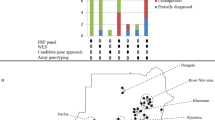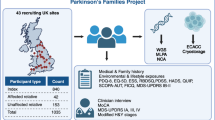Abstract
Machado–Joseph disease (MJD) is an autosomal dominant, multisystem neurodegenerative disorder involving predominantly cerebellar, pyramidal, extrapyramidal, motor neuron and oculomotor systems. Although it was first reported in families of Portuguese–Azorean descent, MJD has also been described in non–Azorean families from various countries, being one of the most common hereditary spinocerebellar degenerations. With the use of highly polymorphic microsatellite DNA polymorphisms, we have assigned the gene for MJD to the long arm of chromosome 14 (14q24.3–q32) by genetic linkage to microsatellite loci D14S55 and D14S48 (multipoint lod score Zmax=9.719).
This is a preview of subscription content, access via your institution
Access options
Subscribe to this journal
Receive 12 print issues and online access
$209.00 per year
only $17.42 per issue
Buy this article
- Purchase on SpringerLink
- Instant access to full article PDF
Prices may be subject to local taxes which are calculated during checkout
Similar content being viewed by others
References
Nakano, K.K., Dawson, D.M. & Spence, A. Machado disease. A hereditary ataxia in Portuguese emigrants to Massachusetts. Neurology 22, 49–55 (1972).
Woods, B.T. & Schaumburg, H.H. Nigro-spino-dentatal degeneration with nuclear ophthalmoplegia. A unique and partially treatable clinicopathological entity. J. neurol. Sci. 17, 149–166 (1972).
Rosenberg, R.N., Nyhan, W.L., Bay, C. & Shore, P. Autosomal dominant striatonigral degeneration. A clinical, pathologic, and biochemical study of a new genetic disorder. Neurology 26, 703–714 (1976).
Lima, L. & Coutinho, P. Clinical criteria for diagnosis of Machado–Joseph disease: Report of a non-Azorean Portuguese family. Neurology 30, 319–322 (1980).
Healton, E.B., Brust, J.C.M., Kerr, D.L., Resor, S. & Penn, A., Presumably Azorean disease in a presumably non-Portuguese family. Neurology 30, 1084–1089 (1980).
Sakai, T., Ohta, M. & Ishino, H. Joseph disease in a non-Portuguese family. Neurology 33, 74–80 (1983).
Yuasa, T. et al. Joseph's disease: Clinical and pathological studies in a Japanese family. Ann. Neurol. 19, 152–157 (1986).
Kitamura, J., Kubuki, Y., Tsuruta, K., Kurihara, T. & Matsukura, S. A new family with Joseph disease in Japan. Homovanillic acid, magnetic resonance, and sleep apnea studies. Arch. Neurol. 46, 425–428 (1989).
Bharucha, N.E., Bharucha, E.P. & Bhabha, S.K. Machado–Joseph–Azorean disease in India. Arch. Neurol. 43, 142–144 (1986).
Suite, N.D.A., Sequeiros, J. & McKhann, G.M. Machado–Joseph disease in a Sicilian–American family. J. Neurogenet. 3, 177–182 (1986).
Barbeau, A. et al. The natural history of Machado–Joseph disease. An analysis of 138 personally examined cases. Can. J. neurol. Sci. 11, 510–525 (1984).
Rosenberg, R.N. Machado–Joseph disease: An autosomal dominant system degeneration. Mov. Dis. 3, 193–203 (1992).
Romanul, F.C.A., Fowler, H.L., Radvany, J., Feldman, R.G. & Feingold, M. Azorean disease of the nervous system. New Engl. J. Med. 296, 1505–1508 (1977).
Yakura, H., Wakisaka, A., Fujimoto, S. & Itakura, K. Hereditary ataxia and HL–A genotypes. New Engl. J. Med. 291, 154–155 (1974).
Jackson, J.F., Currier, R.D., Terasaki, P.I. & Morton, N.E. Spinocerebellar ataxia and HLA linkage. Risk prediction by HLA typing. New Engl. J. Med. 296, 1138–1141 (1977),
Ranum, L.P.W. et al. Localization of the autosomal dominant HLA-linked spinocerebellar ataxia (SCA1) locus, in two kindreds, within an 8-cM subregion of chromosome 6p. Am. J. hum. Genet. 49, 31–41 (1991).
Zoghbi, H.Y. et al. The gene for autosomal dominant spinocerebellar ataxia (SCA1) maps telomeric to the HLA complex and is closely linked to the D6S89 locus in three large kindreds. Am. J. hum. Genet. 49, 23–30 (1991).
Gispert, S. et al. Chromosomal assignment of the second (Cuban) locus for autosomai dominant cerebellar ataxia (SCA2) to human chromosome 12q23–24.1. Nature Genet. 4, 295–299 (1993).
Myers, S.M., MacLeod, P.M., Forse, R.A., Forster-Gibson, C.J. & Simpson, N.E. Machado–Joseph disease: linkage analysis between the loci for the disease and 18 protein markers. Cytogenet. Cell Genet. 43, 226–228 (1986).
Takiyama, Y. et al. A large Japanese family with Machado–Joseph disease: clinical and genetic studies. Acta Neurol. Scand. 79, 214–222 (1989).
Carson, W.J. et al. The Machado–Joseph disease locus is different from the spinocerebellar ataxia locus (SCA1). Genomics 13, 852–855 (1992).
Forse, R.A., MacLeod, P., Holden, J.J.A. & White, B.N. DNA marker studies show that Machado Joseph disease is not an allele of the Huntington disease locus. J. Neurogenet. 5, 155–158 (1989).
Weber, J.L. & May, P.E. Abundant class of human DNA polymorphisms which can be typed using the polymerase chain reaction. Am. J. hum. Genet. 44, 388–396 (1989).
Weber, J.L., Kwitek, A.E. & May, P.E. Dinucleotide repeat polymorphism at the D14S34 locus. Nucl. Acids Res. 18, 4638 (1990).
Bowden, D.W. et al. Identification and characterization of 23 RFLP loci by screening random cosmid genomic clones. Am. J. hum. Genet. 44, 671–678 (1989).
NIH/CEPH Collaborative Mapping Group. A comprehensive genetic linkage map of the human genome. Science 258, 67–86 (1992).
Jordan, S.A., McWilliam, P., O'Briain, D.S. & Humphries, P. Dinucleotide repeat polymorphism at the D14S42 locus. Nucl. Acids. Res. 19, 1171 (1991).
Sharma, V., Smith, L., Allen, L., Magenis, R.E. & Litt, M. Dinucleotide repeat polymorphism at the D14S43 locus. Nucl. Acids Res. 19, 1722 (1991).
Wang, Z. & Weber, J.L. Continuous linkage map of human chromosome 14 short tandem repeat polymorphisms. Genomics 13, 532–536 (1992).
Luty, J.A. & Litt, M. Dinucleotide repeat polymorphism at the D14S45 locus. Nucl. Acids Res. 19, 4308 (1991).
Lathrop, G.M. & Lalouel, J.M. Easy calculations of lod scores and genetic risks on small computers. Am. J. hum. Genet. 36, 460–465 (1984).
Hirayama, K. et al. in Annual Report of Research Committee for Ataxic Disease (in Japanese) 29–44 (The Ministry of Health and Welfare, Tokyo, 1991).
Risch, N. A note on multiple testing procedures in linkage analysis. Am. J. hum. Genet. 48, 1058–1064 (1991).
Ott, J. in Analysis of Human Genetic Unkage Revised edn 74–76 (Johns Hopkins University Press, Baltimore, 1991).
Schellenberg, G.D. et al. Genetic linkage evidence for a familial Alzheimer's disease locus on chromosome 14. Science 258, 668–671 (1992).
St George-Hyslop, P.H. et al. Genetic evidence for a novel familial Alzheimer's disease locus on chromosome 14. Nature Genet. 2, 330–334 (1992).
Van Broeckhaven, C. et al. Mapping of a gene predisposing to early-onset Alzheimer's disease to chromosome 14q24.3. Nature Genet. 2, 335–339 (1992).
Mullan, M. et al. A locus for familial early-onset Alzheimer's disease on the long arm of chromosome 14 proximal to the α1-antichymotrypsin gene. Nature Genet. 2, 340–342 (1992).
Maniatis, T., Fritsch, E.F. & Sambrook, J. Molecular cloning: A Laboratory Manual 2nd edn (Cold Spring Harbor, New York, 1989).
Author information
Authors and Affiliations
Rights and permissions
About this article
Cite this article
Takiyama, Y., Nishizawa, M., Tanaka, H. et al. The gene for Machado–Joseph disease maps to human chromosome 14q. Nat Genet 4, 300–304 (1993). https://doi.org/10.1038/ng0793-300
Received:
Accepted:
Issue Date:
DOI: https://doi.org/10.1038/ng0793-300
This article is cited by
-
Diagnostic Delay of Hereditary Ataxias in Brazil: the Case of Machado-Joseph Disease
The Cerebellum (2022)
-
Mutant Ataxin-3–Containing Aggregates (MATAGGs) in Spinocerebellar Ataxia Type 3: Dynamics of the Disorder
Molecular Neurobiology (2021)
-
PolyQ-expanded ataxin-3 protein levels in peripheral blood mononuclear cells correlate with clinical parameters in SCA3: a pilot study
Journal of Neurology (2021)
-
The blood-brain barrier is disrupted in Machado-Joseph disease/spinocerebellar ataxia type 3: evidence from transgenic mice and human post-mortem samples
Acta Neuropathologica Communications (2020)
-
Repeat Expansion Disorders: Mechanisms and Therapeutics
Neurotherapeutics (2019)



